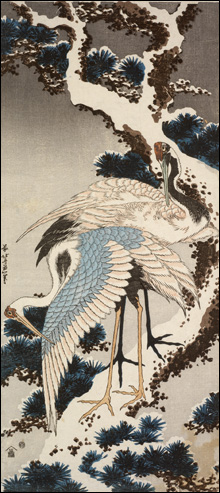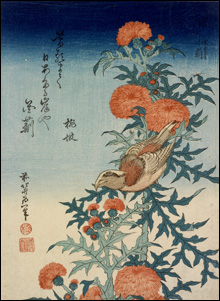
MASTERFUL: Hokusai’s “Cranes and Pines in Snow” [c. 1834].
|
Goshawks scowl atop knotty bent branches, kingfishers stare intently down at water, and dragonflies alight on begonias in the RISD Museum’s new exhibition, “Feathers, Flowers, Talons, and Fangs: Power and Serenity in Japanese Nature Prints.”
Curator Deborah Del Gais assembles some 60 Japanese woodblock prints from the museum’s collection, focusing on the Edo period’s (1603-1867) bird-and-flower style, to bring it out of from its usual place, hidden in the shadows of the era’s acclaimed people, landscape, and narrative prints.
Here the best prints are almost invariably by the masters Katsushika Hokusai and Utagawa Hiroshige. A pair of spindly-legged cranes perch awkwardly on a snowy branch in Hokusai’s Cranes and Pines in Snow (c. 1834). The composition is animated by the S-curve of the branch and, as is common in these works, the tension between realism and stylization, between detail and blank space. Our eyes are drawn back and forth between the bold design of the pine needles and branch and the fine detail of the birds’ plumage. This stylistic shift seems to suggest how the scene might be seen in nature — the background blurring into a generalized shape as you focus on the birds.
Another common element is dramatic cropping. Hokusai employs the classic Chinese “cut-off branch” composition in his Bullfinch and Weeping Cherry (c. 1834), in which a single branch, bursting with white blossoms, curves down through a blue background and, near the bottom, an alert brown bird hangs upside-down.
A goggle-eyed duck with regal plumage drifts under reeds in Hiroshige’s Mallard Swimming Under Snow-Laden Reeds (1830s). He adopts a similar composition, but to much more dramatic effect in Mandarin Ducks in a Stream (1830s), in which a pair of boldly patterned ducks, their heads curled in opposite directions as if in a synchronized dance, swim in the wild blue stripes of a stream.
The exhibit explains that the Japanese attention to nature arose from ancient Shinto teachings of sacred spirit temporarily inhabiting trees, rocks, and waterfalls. This concern was reinforced by Buddhism’s respect for all life, when it was imported from China and Korea in the 6th century.
The prints are rife with symbolism, often drawn from Chinese art: cranes equal long life; pines equal winter, longevity, and endurance; cherry blossoms equal spring and transience. Many of the images draw their subjects from poems, with bits of the texts incorporated into the design. Some of the pictures are elaborate puns, as in a 1760s print in which butterflies flutter over a cat curled up on grass. In Chinese, the wall text explains, the word for cat sounds like the word for age 80 to 90 and the word for butterfly sounds like the word for age 70 to 80. The sounds aren’t the same in Japanese, but the meaning — wishes for long life — carried over.

SYMBOLIC: Katsushika Hokusai’s “Shrike and Thistles” [c. 1834].
|
While Hokusai and Hiroshige have pizzazz, the show is generally serene. Frankly, all the birds and flowers get a bit boring. In Isoda Koryusai’s White Herons and Snow-Covered Reeds (c. 1773) and Katsukawa Shunsen’s Cranes, Pines and Rising Sun on New Year’s Day (1810s), the paper is embossed to pick out the white on white plumage of the birds or the wiggling river current, but the prints are otherwise unremarkable.
I gravitate to the exceptions to the exhibit’s focus, like Nagasawa Rosetsu’s painting Wisteria and Birds (1790s), which is included to show a stylistic source for the woodcuts. Rosetsu draws the branches with a brush lightly-loaded with ink and dragged across the silk so that its line beautifully frays. At the bottom, tiny finely-observed birds flutter and hop. And then our eyes are drawn back up again by a little yellow butterfly and bright red blossom. He distills the scene into a few lovely shapes and calligraphic lines.
If you go, check out a small companion exhibit, “Nuance in Nature: Birds and Flowers in Japanese Textiles.” A flock of cranes flap through curling gold clouds before the snowy peak of Mt. Fuji on the back of a late 19th- or early 20th-century kimono. At the bottom, shimmering egrets wade among gold marsh reeds. And a 19th-century silk court robe dazzles with its pattern of white flowers blooming from polka dot branches against a crimson background.
“Feathers, Flowers, Talons, And Fangs: Power And Serenity In Japanese Nature Prints” Risd Museum, 224 Benefit St, Providence | Through June 10